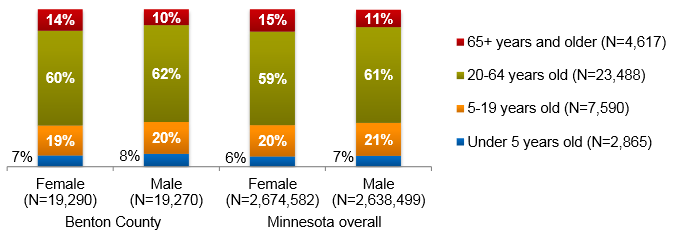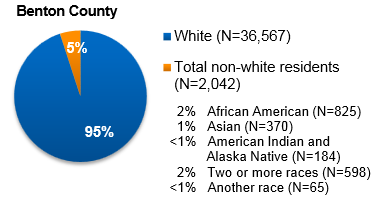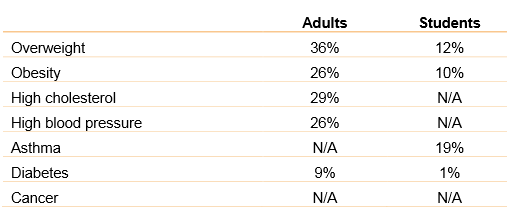Introduction
While working as a community public health nurse, a specialist in the field should understand the features of the community, and she or he should be able to address the needs of this diverse group. The exploration of the public health in the community is an important stage in the nurse’s work in order to become able to respond to not only individual health issues but also to the problems typical for the whole community (Allender, Rector & Warner 2014, p. 460).
The completion of the health needs assessment and the development of the community profile can be discussed as important steps in order to evaluate the community’s health state and the aspects of the health services provided within the concrete area. Benton County is a county located in the central part of Minnesota, and the community of this county is under discussion in the current report (Benton County community 2008, p. 6).
In order to address the community health problems effectively, it is necessary to assess the community’s health within these territories with the help of the specific needs assessment strategy (Ivanov & Blue 2008, p. 227).
The purpose of this report is to discuss the community needs assessment strategy that is used to identify the needs of the Benton community, to present and analyze the community’s demographics and epidemiological data, to discuss the current community’s practice in addressing the needs, and to discuss the implementation of the action plan in order to address the identified community health needs.
Data Collection Process: The Conceptual Framework for Identifying Health Needs
The collection of the community health data can be realized with the focus on many conceptual frameworks that are used for identifying specific health needs of the public. The conceptual framework to determine the needs of the community living in Benton County, Minnesota, was selected with the focus on the specific purpose of the needs assessment. The purpose was to understand what factors can influence the community’s health, what health needs are prioritized, and what interventions are necessary to change the situation for better.
In order to conduct the assessment of needs in the community of Benton County, it was rational to refer to the collection of the primary and secondary data in order to receive the complete information on the health status within the explored community (Allender, Rector & Warner 2014, p. 465).
As a result, a survey based on the self-administered questionnaire was used to collect the primary data regarding the health needs in Benton County, and the examination of the state and local health status reports was selected as a method to collect the secondary data.
The framework that combines the focus on the primary and secondary data is most efficient and acceptable for conducting the needs assessment for such a large population group as a community. A survey based on the self-administered questionnaire is an effective and feasible method to collect the primary data with the focus on answers of the survey participants as representatives of the community (Allender, Rector & Warner 2014, p. 465; Ivanov & Blue 2008, p. 229).
An effective self-administered questionnaire should include questions on participants’ age, ethnicity, literacy level, employment; on the community environment; on the access to health care and on the access to health care information and programs; and on the specific health concerns (Community health needs assessment survey 2014).
The community survey was conducted with the help of a self-administered questionnaire that was distributed among the survey participants from the community via e-mail. The self-administered questionnaire included 15 closed-ended and open-ended questions. The secondary data was collected with the help of the review of the existing reports on the health status of the community in Benton County.
Results: The Community Practice Area and the Population Group
The Geographic Location
Benton County is one of the smallest counties located in the central part of Minnesota. The county borders on Mille Lacs County, Sherburne County, West-Stearns County, and Morrison County (Benton County community 2008, p. 6). It is possible to state that the community’s needs in water supplies are met with references to such water resources as lakes, and the water area in the county is 4.7 sq. Mi. (Benton County community 2008, p. 6).
The climate can be described as mild, and flora and fauna are typical for this region of the country. Referring to natural disasters, it is possible to note that tornados and hurricanes can be discussed as typical for this part of Minnesota (Benton County, Minnesota 2015; Table 1). In spite of the fact that the majority of the community’s population lives in the urban areas (60%), 40% of the population lives in the rural areas because 82% of lands are agricultural (Benton County, Minnesota 2015).
The county is rich in land resources, and the community focuses on realizing effective waste management strategies in order to avoid water and soil pollution. The community has no problems with the air pollution because of the low use of transport in the county and because of the low industry development in this region.
Table 1. Benton County Location and Geography
The Residential Population
The size of Benton County’s population is about 38,600 people (Benton County, Minnesota, 2015). The community can be discussed as mostly urban. The density of the population is rather low (94/sq mi.) (Benton County, Minnesota, 2015).
Referring to the aspect of gender, the population of the community is balanced, where the male and female population is about 19,300 people (Petersen & MartinRogers 2014, p. 2; Figure 1). The median age in the community is about 34 years. The health care services provided in the community are oriented to the needs of the middle-age population group.

Following the race characteristics, it is important to state that the community’s residents are mostly non-Hispanic whites (about 36,500 people). The non-white population represents only 5% of the population in Benton County (Petersen & MartinRogers 2014, p. 2; Figure 3).

Although the median household income is high in the community and the majority of residents live in their own houses, the percent of poverty in the community is about 7% (Benton County community 2008, p. 6).
Epidemiological Data
In spite of the fact that the representatives of the community are inclined to discuss their health state as good, there are several chronic health conditions reported in relation to the community’s population. More than 60% of the adult population suffers from overweight and obesity. More than 25% of the adult population suffers from high levels of cholesterol and blood pressure (Petersen & MartinRogers 2014, p. 3; Table 2).
Table 2. Chronic Health Conditions of Benton County’s Population, 2013

The participants of the survey were asked about their eating habits in order to discuss the tendency regarding healthy eating in the community. It was found that the members of the community do not prefer eating fruit and vegetables regularly. Thus, about 65% of the community’s population eats one serving of fruit and vegetables a day, when more than 20% of people do not eat even one serving of fruit a day (Petersen & MartinRogers 2014, p. 14; Figure 4). Furthermore, the physical activity among the members of the community is rather low, including exercises and excluding the working activities. The participants of the survey mentioned their preferences regarding the sedentary lifestyle.

The community members were also asked regarding the use of tobacco and alcohol. The secondary data were supported by the primary information. It is noted that 21% of the community’s adult population smokes regularly. 18% of students are also discussed as tobacco users (Petersen & MartinRogers, 2014, p. 12). The regular use of alcohol is typical for about 4% of the community’s population, and about 20% of adults in the community can be discussed as acute drinkers (Benton County community 2008, p. 30).
Current Service Provision
While discussing the current health care providers in the community, it is important to state that there are no hospitals in Benton County (Petersen & MartinRogers 2014, p. 26). As a result, the community’s members suffer from the inappropriate provision of health care services and health care delivery. The members of the community are able to access only two ambulance agencies and one medical clinic, Foley Medical Center, in Benton County (Benton County community 2008, p. 14).
The members of the community also pay attention to the fact that their ability to access the health care facilities is limited also because of the weaknesses of the community’s transportation system. One clinic located in Benton County is rather difficult to access for those persons who are living in the suburbs and rural territories (Benton County community 2008, p. 14). As a result, many community members have no opportunity to access the provided health care services because of the transportation issue.
Analysis of the Data
The collected information on the geographic location of the community is secondary, and it was taken from the existing reports on the community’s health needs assessment. The information on the residential population, the epidemiological data, and the information on the current provision of health care services in the community are based on the primary and secondary sources.
The gathered data provide much information necessary to determine what health needs and problems are critical for the population of Benton County. The identification of needs should be based on the proper analysis of the collected data with references to the existing studies in the field.
Having focused on the data regarding the geographic location, it is possible to state that the representatives of the community are not at risk of developing respiratory diseases caused by air pollution.
The data on the residential population demonstrates the necessity to develop the health care services for the middle-age group (20-65 years), but the participants of the survey also mentioned the necessity to improve the health care delivery for the elderly population in the community. The majority of the community in Benton County can be discussed as belonging to middle-class families. However, the level of poverty in the community is about 7%, and it can be discussed as rather high (Benton County community 2008, p. 6).
The epidemiological data provides a complete picture regarding the health concerns and health practices in the community. Having analyzed the data, it is possible to state that the population of the community suffers from the low nutritional value of food because of the non-regular consumption of fruit and vegetables. Only 20% of the population consumes 3 or 4 servings of vegetables regularly. The number for the consumption of 3 or 4 servings of fruit is only 12%.
This fact can explain the development of such associated diseases in the community members as overweight, obesity, and high levels of cholesterol (Morrison-Sandberg & Johnson 2011, p. 14). The next identified health concern is the use of tobacco in Benton County. It is reported that 21% of the adult population in the community are regular smokers, and this fact increases the risks of developing asthma, chronic respiratory diseases, and lung cancer in the community’s population (Rath et al. 2012, p. 135).
The other concern associated with the health state in the community is the access to the health care services in Benton County. The delivery of the health care services in the community is not appropriate because of absence of hospitals in the community and because of the necessity to respond to many patients’ needs in one medical center of the community on a daily basis (Entwistle, Firnigl & Ryan 2012, p. 70; Mirzaei & Aspin 2013, p. 252).
Prioritization of the Health Needs
While referring to the analysis of collected data and drawn conclusions, it is possible to identify the health needs for the community with the focus on such prioritization criteria as the prevalence of the problem in the community according to the statistical data, the percentage of the cases that are reported in the conducted assessments, and the focus of the survey’s participants on the concrete health care issues or problems typical for the community (Allender, Rector & Warner 2014).
Having prioritized the identified health needs according to the mentioned criteria, it is possible to state that obesity and overweight among adults in the community is the main health concern. The active tobacco use among the adult population and the lack of access to health care services are also significant problems.
From this point, the main health priority for the population in the community of Benton County is the obesity and overweight among adults. In order to justify the focus on this problem, it is necessary to state that the need was prioritized with references to the answers of the survey’s participants to the questionnaire and with references to the analysis of the local and state statistical data on the health status in the community.
Much information is provided on the percentage of overweight or obese adults in the community and on their problems with high levels of cholesterol and diabetes as a result of the obesity problem (Tovar, Chui & Hyatt 2012, p. 102). Therefore, the residents of Benton County in Minnesota are at risk of developing chronic diseases and diabetes associated with overweight and obesity because of unhealthy eating habits, poor nutrition, and lack of the knowledge and services in this sphere of care (Ogden et al. 2014, p. 806).
Actions Taken in the Community
It is important to state that the community’s authorities developed the strategies to address the main health problem in Benton County, but more activities are necessary for the field. Thus, the Minnesota Department of Health developed the program in which Benton County actively participates since 2011.
The Statewide Health Improvement Programme (SHIP) is oriented to reduce health problems associated with overweight and obesity, active tobacco use, and low levels of physical activity among the population (Benton County Community Health Board 2011).
The current accomplishments of the program are associated with promoting plans on healthy eating and physical activity at schools, educating the adult and child population, and proposing comprehensive programs and initiatives to support the wellness of the population in Minnesota, including the members of Benton County.
Community Engagement
The survey on the community’s health needs to demonstrate the rather high engagement of the community’s population in the needs assessment process. The engagement of the population in the needs assessment process is often discussed by researchers as a challenge because of the necessity to evaluate the perception of the health status by the wide group of population (Allender, Rector & Warner 2014).
Although it was difficult to engage a large percent of the community’s population in the survey conducted via e-mail, the information collected with the help of the involved population is important to analyze the approaches followed in the community to address the problem of overweight and obesity. The lack of primary data on the problem was compensated with the focus on the recent secondary sources and health needs assessments conducted in the community.
The involvement of the community’s population in the survey conducted to complete the needs assessment process in the community allows focussing on the planning and implementation of the action plan in order to address the identified health need (Ivanov & Blue 2008).
Referring to the identified problems and lacks in resources and services, it was planned to develop the strategy to address the problem of obesity and overweight in the community and reduce the risk of chronic diseases associated with obesity and overweight while improving the community members’ knowledge of healthy eating habits and promoting the access to fresh and nutritional products to increase the consumption of the healthy food (Morrison-Sandberg & Johnson 2011; Ogden et al. 2014).
Conclusion
The population of Benton County experiences many health challenges associated with the lack of healthy habits and access to the developed health care infrastructure as well as knowledge on the basis of a healthy lifestyle. As a result, the community health need is associated with the problem of overweight and obesity caused by the population’s focus on unhealthy eating habits.
The other problems include the high level of tobacco use and the lack of access to health care services. Thus, the community’s residents are at risk of developing chronic diseases caused by unhealthy eating habits, lack of physical activity, and a sedentary lifestyle.
Reference List
Allender, J., Rector, C. & Warner, K. 2014, Community health nursing: promoting and protecting the public’s health, Lippincott, Williams, and Wilkins, Philadelphia.
Benton County community health assessment and action plan 2008-2009, 2008. Web.
Benton County Community Health Board 2011. Web.
Benton County, Minnesota 2015.
Community health needs assessment survey SCS 2014. Web.
Entwistle, V., Firnigl, D. & Ryan, M. 2012, ‘Which experiences of health care delivery matter to service users and why? A critical interpretive synthesis and conceptual map’, JHSRP, vol. 17, no. 2, pp. 70-78.
Ivanov, L. & Blue, C. 2008, Public health nursing: policy, politics & practice, Cengage Learning, New York.
Mirzaei, M. & Aspin, C. 2013, ‘A patient-centered approach to health service delivery: improving health outcomes for people with chronic illness,’ BMC, vol. 13, no. 2, pp. 251-263.
Morrison-Sandberg, L. & Johnson, K. 2011, ‘Obesity prevention practices of elementary school nurses in Minnesota: findings from interviews with licensed school nurses,’ The Journal of School Nursing, vol. 27, no. 1, pp. 13-21.
Ogden, C., Carroll, M., Kit, B. & Flegal, K. 2014, ‘Prevalence of childhood and adult obesity in the United States, 2011-2012’, JAMA, vol. 311, no. 8, pp. 806-814.
Petersen, A. & Martin Rogers, N. 2014, Benton County SHIP.
Rath, J., Villanti, A., Abrams, D. & Vallone, D. 2012, ‘Patterns of tobacco use and dual-use in U.S. young adults: the missing link between youth prevention and adult cessation,’ JEPH, vol. 679, no. 1, pp. 134-142.
Tovar, A., Chui, K. & Hyatt, R. 2012, ‘Healthy-lifestyle behaviors associated with overweight and obesity in U.S. rural children,’ BMC Pediatrics, vol. 12, no. 6, pp. 102-110.